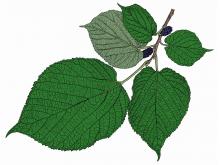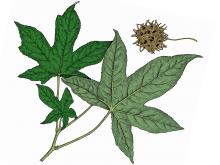Trees, Shrubs and Woody Vines
Media

Species Types
Scientific Name
Quercus bicolor
Description
A beautiful tree, swamp white oak features bicolored leaves that are shiny, dark green above and downy white below. When a breeze sets them in motion, their wavy or lobed shapes add a calm grace to a summer's hike.
Media

Species Types
Scientific Name
Quercus falcata
Description
This tree has two names as well as two leaf types! In Missouri, southern red oak, or Spanish oak, occurs natively only in our southeast and southernmost counties.
Media

Species Types
Scientific Name
Quercus pagoda
Description
The bark of cherrybark oak looks like the bark of a cherry tree. When you hold one of the leaves with the leaf stalk upward, the pointed lobes make the leaf resemble an outline of a Chinese pagoda. This oak grows in Missouri's Bootheel.
Media

Species Types
Scientific Name
Various species in the genus Crataegus
Description
Our state flower, the hawthorn, is solidly represented in Missouri. There are about 100 different kinds of hawthorns that occupy almost every kind of soil in every part of the state. These members of the rose family are closely related to apples.
Media

Species Types
Scientific Name
Ilex decidua
Description
Possum haw, or deciduous holly, is the more common of two native Missouri hollies that lose their leaves each fall. This shrub or small tree is eye-catching in the fall and winter with its bright red berries.
Media

Species Types
Scientific Name
Morus rubra
Description
Red mulberry is native to Missouri and North America. You can distinguish it from the introduced white mulberry tree, which is a noxious weed, by its leaves and fruits.
Media

Species Types
Scientific Name
Platanus occidentalis
Description
The white, smooth-looking limbs of sycamore rise over countless streams and river banks, as well as over sidewalks and city streets. The leaves, which somewhat resemble those of maples, can reach remarkably large sizes.
Media

Species Types
Scientific Name
Liquidambar styraciflua
Description
The star-shaped leaves of sweet gum become even more striking in the autumn, when they turn various shades of gold, red, pink, and purple, often on the same tree — sometimes even on the same leaf!
Media

Species Types
Scientific Name
Populus deltoides
Description
Named for the cottony fluffs of hairs attached to its tiny seeds, cottonwood thrives in moist lowlands near streams and rivers. It is Missouri’s fastest-growing native tree but pays for that distinction by being relatively short-lived.
Media

Species Types
Scientific Name
Carpinus caroliniana
Description
American hornbeam is also called musclewood because of the sinewy appearance of its smooth gray bark. The name hornbeam refers to the genuine strength of its wood — it is one of the hardest and strongest woods in North America.
See Also
About Trees, Shrubs and Woody Vines in Missouri
There are no sharp dividing lines between trees, shrubs, and woody vines, or even between woody and nonwoody plants. “Wood” is a type of tissue made of cellulose and lignin that many plants develop as they mature — whether they are “woody” or not. Trees are woody plants over 13 feet tall with a single trunk. Shrubs are less than 13 feet tall, with multiple stems. Vines require support or else sprawl over the ground.





















